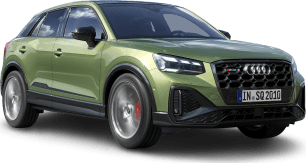The RS3’s standard sport front seats are deliciously comfortable and offer plenty of electric adjustment. This means people of any size and stature should be able to find their desired seating position.
Thanks to the electric lumbar there’s also a massage function for the front seats. This is pretty cool to flick on and relax into, but I wish the massage was a little stronger.
While the new steering wheel looks cool interacting with the buttons on it can be a bit of a hassle. They’re touch-sensitive but do have a satisfying click if pressed harder.
There were moments where I accidentally clicked on the buttons during intensive track driving as my hands were at the nine and three o’clock positions. Not the best thing when you’re meant to be focussing.
The digital instrument cluster offers so much configuration you won’t know what to do with yourself. There’s even a new rev counter design especially for the RS3 which looks very cool.
Moving across, the touchscreen multimedia system is classic Audi. It’s easy to navigate around and hard to get lost in the sub-menus. There’s also wireless Apple CarPlay and Android Auto connectivity which is virtually a given now.
While you need to use the touchscreen for a number of features, I appreciate how Audi has retained so much physical switchgear up front. It’s particularly handy to have physical toggle switches and a small digital display that’s separate from the touchscreen for the climate control.
Another piece of physical switchgear I like up front is the rotary dial for the media controls on centre console. It’s much like an iPod, allowing you to change the volume if you rotate your finger on it like a click-wheel. Major throwback vibes.
In terms of storage up front, it’s decent but not outstanding. There are two cupholders, a wireless phone charger, a centre console box as well as a lockable glove box.
Moving to the second row, it’s clear it’s more for the sake of it, rather than having a space you’d want to use all the time. At a leggy 182cm tall, I have minimal legroom behind my own driving position.
With headroom, it’s adequate in the hatchback and not great in the lower-slung sedan. I need to kink my neck in the latter to fit, which isn’t comfortable.
The second-row bench seat is comfortable, offering enough support for short-to-medium trips. I wouldn’t want to get stuck back there for too long, however.
In terms of amenities, there are air vents mounted on the back of the centre console with a dedicated third zone of climate control, two USB-C ports, nets on the seat backs as well as a fold-down centre armrest with cupholders.
At the back there’s a power tailgate for the hatchback, however the sedan only has a power-opening boot lid. This means you need to manually shut it, which isn’t uncommon for sedans.
Boot space in the RS3 is a weak spot due to all the componentry for the all-wheel drive system and the tricky rear clutch set-up. There’s only 282L for the hatch and 321L for the sedan, which isn’t much.
In reality, however, the boot space is still usable. It’s fairly square and there’s barely any boot lip, meaning you can slide things in and out with ease.
Boot-related amenities include a netting system to keep things from sliding around, a light, some hooks and a 12V socket. There’s also a parcel cover for the hatchback.
Unfortunately there’s no spare wheel of any kind under the boot floor in the RS3 as this is where the 12V battery lives. Instead there’s a tyre repair kit. This isn’t uncommon in performance cars, though it’s disappointing if you frequently travel in the country, away from tyre repair shops.






